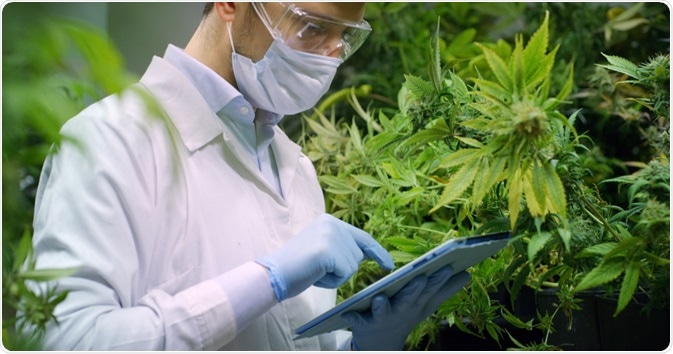With the legalization of cannabis for medicinal and recreational purposes, there is an increase in the research and production of cannabis and cannabis-derived products. To achieve this, more chemicals like pesticides, herbicides, and fungicides are used to avoid infestations of insects and contaminations of microbes.

Cannabis Analysis. Image Credit: HQuality/Shutterstock.com
There is also an increase in illegal applications of these chemicals to obtain the maximum yield. So, the applications of these chemicals raised concerns about potential toxicology for human health. Therefore, pesticide analysis is of prime importance in cannabis to circumvent serious health issues in consumers either for medicinal or recreational activities.
In recent years, cannabis and cannabinoids have gained greater significance due to their medicinal and recreational properties. As the focus on their use and research increases, the application of fungicides, pesticides, and bactericides has also increased to combat diseases and increase yield. That's why it is crucial to test cannabis and cannabis-derived products for both authorized and unauthorized pesticides. And the continuous and unchecked application of pesticides for more production yields harmful impacts for humans and the environment.
For that reason, the pesticide analysis in cannabis should have important, sensitive, and selective testing methods to check for toxic compounds. The purpose of these testing methods should be to control the quality of the cannabis products (for mycotoxins) and check for potential human hazards.
Another reason to test pesticide residues in cannabis is the medical patients. Because medical cannabis patients are more prone to pesticide contaminants and residues presented health risks. These pesticide residues also pose serious health risks in patients, particularly with weaker immune systems. So, it is imperative to screen cannabis and cannabinoid products properly and effectively for pesticide residues.
Pesticide residues in cannabis and their impacts
The pesticide residue in cannabis and cannabinoid products causes serious health issues in consumers. Such as the consumption (inhalation) of contaminated dried cannabis could become a part of the bloodstream, thus presenting a serious health hazard. The presence of pesticides in dried cannabis can cause the decomposition of pesticides into toxic chemicals or mixtures. So, the inhalation of dried cannabis smoke may expose smokers to a greater level of degraded toxic chemicals with safety concerns in patients, etc.
A study published in the Journal of Toxicology highlighted the potential risks of pesticide contaminations in cannabis. And also found that almost 69.5% of pesticide residues remain in dried cannabis and cause negative health issues. The higher concentrations of pesticides in cannabis positively correlate, the higher exposure possibility of severe illness in customers.
Categorization of pesticides
The federal pesticide law of the United states breakdown the pesticides into the following categories:
According to laws:
Organic pesticides only allowed for organic production. These pesticides will be evaluated by National Organic Standards Board (NOSB) for their impact on human health, the environment, and workers that deal with the cultivation of cannabis.
Federally registered pesticide, these pesticides are scientifically (investigated for active ingredient) evaluated by the environmental protection agency (EPA) for minimum risk to environmental health. The chemical under evaluation includes herbicides, rodenticides, insecticides, fungicides, antimicrobial products, and biopesticides.
Federally exempt pesticides with minimum risks, these pesticides do not undergo evaluation and registration process. As the active ingredient in such pesticides is regarded as safe for indented use.
According to Oregon State, the pesticide residue level in federally registered pesticide that is acceptable is 0.1ppm. In the United States, the pesticide residues of crops and vegetables are regulated by The Federal Insecticide, Fungicide, and Rodenticide Act (FIFRA).
Testing methods for pesticide analysis in cannabis
The testing of cannabis for pesticides, mycotoxins, terpene contents, heavy metals, and pathogenic spores requires sample preparation, cleaning, and robustness of the chosen method. And the analysis is performed for leaves, dried flowers, and oil, respectively.
In cannabis and cannabis-derived products, the pesticide analysis is performed by liquid-liquid extraction, solid-phase extraction, The Quick, Easy, Cheap, Effective, Rugged, and Safe (QuEChERS) while the detection is performed through capillary electrophoresis, high-performance liquid chromatography (HPLC), and gas chromatography in association with mass spectrometers.
For pesticide residue analysis in cannabis, The Quick, Easy, Cheap, Effective, Rugged, and Safe is an effective extraction technique for high-performance liquid chromatography. According to health regulatory authorities, the pesticide contamination limits in cannabis should be between 0.01-3.00 μg/g.
References:
- Moulins, J.R., Blais, M., Montsion, K., Tully, J., Mohan, W., Gagnon, M., McRitchie, T., Kwong, K., Snider, N. and Blais, D.R., 2018. Multiresidue method of analysis of pesticides in medical cannabis. Journal of AOAC International, 101(6), pp.1948-1960. DOI: 10.5740/jaoacint.17-0495
- Feldman, J., 2014. Pesticide use in marijuana production: safety issues and sustainable options. Pesticides and You, 34(4), pp.14-23. http://marijuana.heraldtribune.com/files/2015/03/Pesticide-Use-in-Marijuana-Production.pdf
- Atapattu, S.N. and Johnson, K.R., 2020. Pesticide analysis in cannabis products. Journal of Chromatography A, 1612, p.460656. DOI:10.1016/j.chroma.2019.460656
Further Reading
Last Updated: Jul 12, 2021